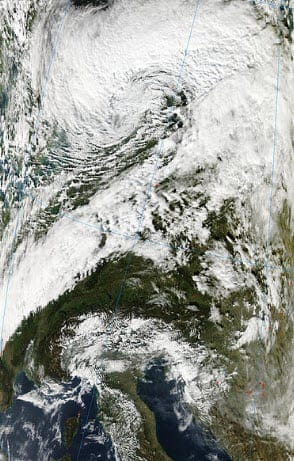According to catastrophe modeling firm AIR Worldwide, Windstorm “Christian” smashed into southern Britain Monday, October 28, knocking over trees, flooding lowlands, and disrupting land, sea, and air travel. (Officially named “Christian” by the designated authority at the Free University, Berlin, the storm has also been called “St. Jude,” “Carmen,” and “Simone” by local weather agencies in other countries.) It was one of the strongest extratropical cyclones to hit the UK in a decade. Gusts of 160 km/h (100 mph) were reported on the Isle of Wight in southern England, and waves greater than 7.5 meters (25 feet) were reported elsewhere along the coast.
After striking the UK, Windstorm Christian raged north and east, hitting France, the Netherlands, northern Germany, and Denmark with similar force: the Ile d’Ouessant, Finistere, France reporting a gust of 133 km/h (83 mph), the Netherlands gusts of 90 to 130 km/h (56 to 81 mph) along the Ijsselmeer coast, and, in southern Denmark, the strongest wind recorded in the country’s history, a gust of 194.4 km/h (120.8 mph). Christian continued north into Sweden (with winds up to 151 km/h) and then across the Baltic Sea to Latvia and Estonia, where conditions remain windy today. Throughout the region conditions are returning to normal as authorities engage in cleanup and repair operations, particularly to clear off roads and rail lines and to restore power.
“Windstorm Christian began as a depression off the east coast of the United States and, assisted by the upper atmosphere jet stream, moved east toward Europe,” said Dr. Gerhard Zuba, senior principal scientist, AIR Worldwide. “The depression developed into a secondary low south of an area of low pressure east of southern Greenland. Windstorm Christian formed only on October 27, following interaction with a wave front coming out of the northwest Atlantic. Remnants of ex-tropical storm Lorenzo contributed an input of energy, helping the deepening low to intensify in an area closer to Europe than normal.”
Dr. Zuba continued, “A strong jet stream above contributed to the low’s strengthening, and Christian intensified rapidly before striking western Europe. It increased in intensity further-an unusual occurrence-while crossing Great Britain, again because of the influence of the jet stream, which was bringing warm air close to the United Kingdom. The storm system moved very quickly once it reached Europe, often at a speed of about 100 km/h (62 mph). Thus, it crossed all of western Europe within less than 24 hours. This unusually fast forward speed helps account for the high wind speeds that have been recorded, but also for the relatively short high wind duration experienced at individual locations, contributing to less serious
damage being caused.”
Dr. Zuba observed, “By Tuesday morning, Windstorm Christian had dissipated considerably as it moved to Sweden’s east coast and out toward the Baltic, although hurricane-force gusts of over 115 km/h were measured on the Baltic islands of Öland and Gotland. Windstorm Christian then moved quickly to the northeast, toward the Baltic countries, with decreasing wind speeds.”
According to AIR, Windstorm Christian was a threat primarily to residential structures. Much of the residential buildings in northern Europe, especially in the United Kingdom, the Netherlands, and Germany, are detached, semi-detached, or terraced (row) houses that are primarily of masonry construction. However, there is significant use of wood construction farther north, especially in Scandinavia.
According to AIR, mid-rise residential buildings generally have exterior non-load bearing walls also made of masonry, but they not uncommonly have light-gauge steel stud walls or concrete panels. When areas with such structures are subjected to high winds, most damage is limited to the rooftops and chimneys of the buildings, although walls are often damaged by flying debris. The most common construction type
for commercial structures is masonry (approximately 50% of the building stock), while the remaining construction is mostly steel frame and reinforced concrete. Little structural damage to these construction types is expected from Christian’s reported wind speeds, although damage to cladding, signage, and some isolated roof covering damage could occur.
At the storm’s height, 600,000 homes were without power in the UK, at least 65,000 in just Brittany, Normandy, and Picardy in France, 100,000 in Denmark, about 70,000 in Sweden, 100,000 in Latvia, and about 60,000 in Estonia.
Transportation systems throughout the region, including roads, trains, airports, and some ports have been shut down. For surface travel, fallen trees have been the main cause of much of the disruption. London’s Heathrow Airport, Europe’s busiest, cancelled at least 130 flights; 50 flights were cancelled at msterdam’s Schiphol Airport. At Rotterdam Port, Europe’s busiest shipping port, incoming and outgoing vessels have been delayed, while giant waves closed the major English port of Dover, cutting off ferry services to France.
Many local reports describe damage to cars and homes by overturned trees, exterior damage to many homes, sign damage, collapsed scaffolding, and damage to the facades of many businesses. Flying debris falling on incoming power lines interrupted power to the Dungeness nuclear power station in Kent in the UK, initiating an automatic shutdown of the station. It is not expected to be back in service for seven days.
Dr. Zuba concluded, “By midday October 29, Windstorm Christian had dissipated over northern Europe, although heavy winds and rain are still affecting some parts of the region. By later in the day, the storm had reached St. Petersburg in Russia, where gale warnings have forced authorities to activate city flood protection systems. Between 3:00 and 3:30 p.m. local time, the level of the Neva River rose from 86
centimeters to 111 centimeters (about 34 inches to almost 44 inches) as measured by the gauging station at St. Petersburg’s Mining Institute.”
AIR has begun collecting observation data from stations across Europe and a damage survey is also underway.
AIR will continue to monitor this event closely and will post additional information if necessary.
